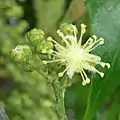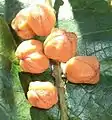Croton sylvaticus
Croton sylvaticus is a tree in the family Euphorbiaceae. It is commonly known as the forest fever-berry. These trees are distributed in forests from the east coast of South Africa to Tropical Africa. It grows 7–13 m in height, occasionally up to 30 m, in moist forests, thickets and forest edges at altitudes of 350–1800 m.
| Croton sylvaticus | |
|---|---|
 | |
| Scientific classification | |
| Kingdom: | Plantae |
| Clade: | Tracheophytes |
| Clade: | Angiosperms |
| Clade: | Eudicots |
| Clade: | Rosids |
| Order: | Malpighiales |
| Family: | Euphorbiaceae |
| Genus: | Croton |
| Species: | C. sylvaticus |
| Binomial name | |
| Croton sylvaticus Muell. Arg. | |
Flowers and fruit
Greenish cream flowers, up to 3 mm long (all male or female or mixed flowers), in racemes, 10–30 cm long. Fruit, light green when young, turning to orange or red, trilobed, oval in shape, hairy.
Uses
Used as a general timber, for poles, posts and as a fuel.
Traditional medicine
Sap from leaves is used for healing cuts, bark is used in the treatment of malaria, a decoction from the bark of the roots is taken orally as a remedy for tuberculosis, an infusion of the leaves acts as a purgative.[1]
Gallery
 Crown.
Crown. Young stem.
Young stem. Leaves.
Leaves. Flower buds on inflorescence.
Flower buds on inflorescence. Flower.
Flower. Fruit.
Fruit. Seeds.
Seeds.
See also
References
- Field Guide to Common Trees & Shrubs of East Africa by Najma Dharani, Struik Publishers, Cape Town, South Africa, 2002, ISBN 1-86872-640-1
- Pooley, E. (1993). The Complete Field Guide to Trees of Natal, Zululand and Transkei. ISBN 0-620-17697-0.